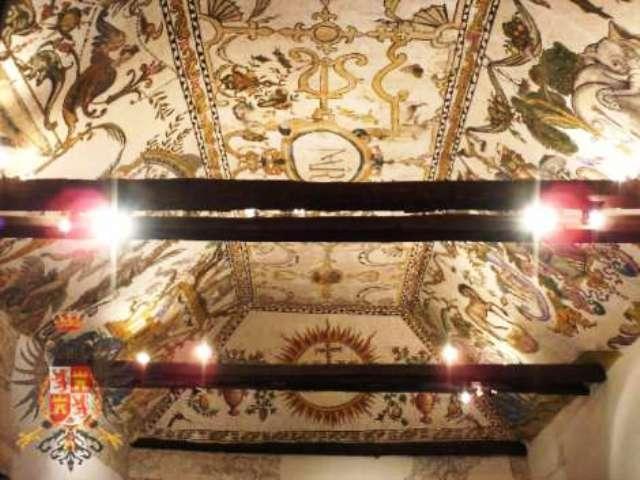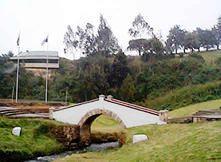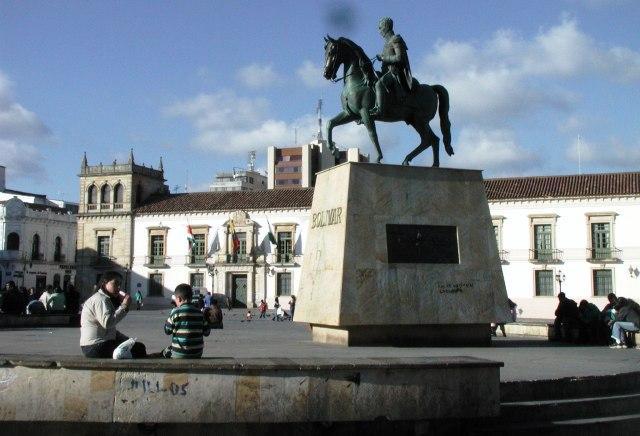Tunja, Boyacá, Colombia
Suggest Place to Visit
1492
Track to location with GPS |
 |
In Tunja several events of great importance and repercussion took place; on December 9, 1811, the constitution of the Republic of Tunja was sanctioned; On December 10, 1813, the absolute independence of Spain, from the Province of Tunja, was proclaimed in November 1814, with the Congress of the United Province of New Granada meeting, chaired by Don Camilo Torres, the future liberator was presented Simón Bolívar to report on his successes and failures in his campaign.
On the apparently arid lands of Tunja, wheat was born for the first time in the New Kingdom of Granada, in 1541, brought by the Spanish lawyer Jerónimo Lebrón Governor of Santa Marta, who left the seeds to another Spanish nobleman named Jerónimo de Aguayo, who worked the soils and obtained a magnificent harvest.
Tunja, Capital of Boyacá was founded in 1539 by Gonzalo Suárez Rendón, in the seat of an important Muisca chiefdom and capital of the Province from the beginning, Tunja keeps rich testimonies of its colonial splendor. In 1812 it was the seat of the Congress of the United Provinces of New Granada, a libertarian gesture that would be worth it to be occupied by Pablo Morillo in 1816. Today it stands out for its active cultural life.
Junza or Tchunza, which in the Chibcha language means powerful man or prudent man. '' Tunja was the name given by the Muiscas to the Chieftain of the Zaques, whose extensive territory included the towns of the Hunza or Tchunza (headquarters capital of the Cacicato), Ramiriquí, Turmeque, Tibana, Tenza, Garagoa, Somondoco, Lenguazaque, Tuta, Motavita, Sora and other smaller indigenous peoples
The name of the current city has been known since pre-Hispanic times. ´´When Fonzaque went from Ramiriquí to the top of the mountain range called Gachaneque, he looked towards the north, pointed with his hand to a place with an inclined, arid plane, located at the foot of a not elevated hill and said: there will be TUNJA´´.
´´According to the beautiful Chibcha legends, the oldest Zaque in Tunja was called Hunzahúa, a native of Ramiriquí. This sovereign was greatly feared by his subjects. He distinguished himself by his courage, to the point that the Zipa could not dominate him by arms. He had a quite beautiful sister, a beauty that surpassed that of all the women of the Hunzahúa aboriginal empire, fell in love with his sister and decided to share with Casica the thought that his lover caressed his heart. Her mother did not give her the hand of her daughter because it was forbidden for the Hunzas to carry out links with the same sisters.
´´The refusal filled the soul of the king of the chibchas with sadness. Hunzahúa decided to go to Chipatae and took his sister stolen. At Chipatae he determined to take her as his wife; After several months, the young married couple returned to Tunja and arrived at the Manor House. The mother did not know the path that her children had taken, and when she saw that the beautiful Indian woman was approaching to be her mother, the Cacica's fury was great.
Both were sitting next to a clay pot containing clay in preparation and ferment. La Cacica scolded her daughter for her bond with her own brother. An argument broke out between the old woman and the young woman who got to the heat. The old woman took the healthy one, a stick that was used to stir the chicha, threw a club at the girl, she took cover behind the porridge, the blow hit the pot, the vessel fell into pieces, the liquid spilled on the ground and it instantly formed a small lake of not very pure water ´´.
´´Hunzahúa and her sister decided to abandon the capital of the empire, Hunzahúa before leaving, cursed the city of Tunja, in the following terms; You will be sterile, dear city; no more flowers or trees will see your ground; The land that supports you will be bare and ravishing so that you cannot spread out, and because you were ungrateful and cruel to Hunzahúa, your founder, you will have no companion other than the wind and no shelter other than the cold. Goodbye Hunza, goodbye forever! ´ ´.
Hispanic Foundation
When the Spaniards reached the Hunza lands, the Chibchas threw a large quantity of gold and emeralds into the well, which they carried in flasks from hand to hand of hundreds of indigenous people, from the palace of the zaque to the small lake.
A Spaniard with the surname Donato, at the time of the Colony, spent incalculable fortunes in the search for treasures, without any favorable result. Given the failure of the greedy Hispanic, the pool took the name of Pozo de Donato and since then, when a debt is not paid in Tunja it is said that "it fell into Donato's well," meaning that it was lost forever.
After the Spanish Donato, both during the Colony and during the Republic, there were several unsuccessful attempts to drain the well, with the investment of large sums of money. The legend ends with the statement that at the bottom of the well there is a long and thick beam of solid gold, lying horizontally under the ground, from the water to the Cathedral of Tunja. If the beam could be hit with a heavy hammer, the temple would shake at that moment.
Tunja, capital of the department of Boyacá, keeps in its colonial constructions the mark of the Spanish culture that combines with the aboriginal roots.
Currently the main economic activities on which the city of Tunja depends are represented in the sectors of commerce and services.
The economy is quite diversified: they live from agriculture, livestock, fishing, services, commerce, industry, crafts, oil extraction and mining, especially emeralds. They grow vegetables, legumes, potatoes, corn, barley, sugar cane, wheat, bananas and fruit trees. Boyacá is the first producer of junca onion in the country and the second of potato. Livestock (milk and meat) covers regional markets and the capital of the Republic. As for mining, coal, iron, limestone and emeralds are exploited. It is the first national producer of emeralds in the municipalities of Muzo, Quípama, Coscuez, Maripí, Pauna, Otanche and Buenavista. Iron is exploited especially in Acerías Paz del Río, in the towns of Nobsa and Paz del Río, cement in Nobsa and oil in Puerto Boyacá. The crafts that its inhabitants make are varied but clay figures made in Ráquira, Moniquirá and Cerinza predominate. From the Chivor Hydroelectric Plant, electricity is generated for the country, using the waters of the Batá River. The industrial zone is concentrated in the cities of Sogamoso and Duitama and municipalities such as Nobsa and Paipa. On the other hand, the most important trade is in Duitama and in other municipalities such as Sogamoso, Paipa and Tunja. Tourism is an important line of its economy because its territory, landscape and natural resources are considered a historical monument of the country.
Tunja is an eminently student city; It is home to various university entities, technological education institutions, colleges and schools, to which thousands of young people come to prepare, from the entire department of Boyacá, and even from other national departments.
ATTRACTIVE
HISTORICAL-CULTURAL
PUENTE DE BOYACA: Historic place, located in the village of Boyacá at 14Km. of Tunja. Important tourist center built on the Teatinos river. It was the scene where the Battle of Boyacá took place on August 7, 1819, when the national armies from the plain under the command of Simón Bolívar and Francisco de Paula Santander defeated the royalist army of José María Barreiro.
CASA DEL ESCRIBANO JUAN DE VARGAS: This mansion is an invaluable monument for the pictorial decorations that it houses, undoubtedly the most interesting 16th century in Latin America. Located at Calle 20 No. 8-52. It has mural painting, wood carvings, oil painting and objects from the colonial era; It is under the administration of the Institute of Culture, Tourism and Fine Arts of Boyacá.
EL MONO DE LA PILA: Tunja is kept in reverent respect and when one passes in front of him, silence must be inexorably kept, at least this is the latest popular belief. This monument was built in the main square of Tunja and for 3 centuries, almost all the inhabitants of the Boyacá capital were supplied with water from this public fountain, which came through the ditch of the Varón and Detrás del Alto paths.
The monkey represents the God of silence. His right index finger is on his lips, as if telling the water carriers not to talk so much when they collected the liquid. Work of the sculptor Diego Morales, its initial site was the center of the Plaza de Bolívar, and today it is located on Calle 20 with Carrera 8; the original work is supposed to be in the courtyard of the Dominican Convent in Tunja.
CUSHIONS OF THE ZAQUE: On the slopes of the Alto de San Lázaro to the west of Tunja, there are two stones that are part of the rock, carved by the Chibchas many centuries ago, stones that are known by the name of the Cushions. Located to the west of Tunja, place of worship to the sun.
LA LOMA DE LOS AHORCADOS: Place destined to the executions of the Indians who violated the Muisca laws, known today as the Alto de San Lázaro.
DONATO WELL; Located north of the city, on the premises of the UPTC origin of a Muisca Legend, its name is given by the surname of a Spaniard who tried to drain the well in order to obtain the treasures thrown there by the Muiscas. It is located in the valley, to the north of Tunja and on the side of the central highway.
PAREDON DE LOS MARTIRES: Located in the Forest of the Republic, it receives this name because there were shot the Martyrs Patriots José Cayetano Vásquez, and José Ramón Lineros and Juan Nepomuceno Niño, in the year 1816.
MONUMENT TO THE RACE: Located in the North Glorieta. It is a tribute to the indigenous people.
MONUMENT TO THE WHEAT: Located on the premises of the site, called the Fuente Grande, on diagonal 11 with Carrera 16, where the first crops of this cereal existed, brought for the first time to Tunja by Captain Don Jerónimo de Aguayo.
RELIGIOUS
The Cathedral: Located in the main square. Built at the end of the 16th century, it is a temple with 3 Gothic style naves, 4 chapels where the remains of the founder of Tunja rest. Its construction began in 1567 and was completed in 1607.
Chapel of San Laureano: Religious architecture, located in front of the ´´Bosque de la República´´ It maintains carved and gilded altarpieces. It was the first hermitage built in 1566.
Church of Santa Bárbara: Religious architecture. Located in Carrera 11 No.16-62. Its construction began in 1593 and was completed in 1599. It keeps the oldest ornaments in the city, donated by the Spanish crown.
Santiago de Tunja Cathedral; Located on the eastern side of the Plaza de Bolívar, a church with three naves with side chapels; the most representative are those of Mancipe, that of the Founder, that of the girl Maria. Its Renaissance style portal was made by Bartolomé Carrión.
Church of Santo Domingo; Located on Carrera 11 between streets 19 and 20, it preserves one of the most important chapels in America, such as La Capilla del Rosario, called the Sistine Chapel of America; you can see its columns and details in red backgrounds adorned with gold lamellae.
Church of San Francisco; Located on Carrera 10 with Calle 22, founded in 1550, it has wood carvings, representative of the Catholic religion, such as the altar of the pelicans and the statue of San Francisco on the High Altar.
Church of Santa Bárbara; Built in 1590, the only blue church with a cruciform shape; It has in one of its chapels the image of the first patron saint of Tunja and the Chapel of the Child Jesus, miraculous according to legends.
Church of San Ignacio; Built by the Jesuit community in the seventeenth century, its architecture is in stone, currently it works as a concert hall and is administered by the ICBA.
Santa Clara la Real; Built in 1574 by order of the Mongüa encomendero, the only chapel with a pointed or pointed main arch; moderation is represented on the roof and the decorations that cover the walls. It is the first nunnery to be established in the New Kingdom of Granada. It preserves the cell of Sor Josefa del Castillo and a museum in homage to this representative of American letters.
Monastery of the Topo; Built from 1729, it was inhabited by the Augustinian Recollects until the time of the expropriation of ecclesiastical property. Since the end of the 21st century it has been inhabited by the Conceptionist nuns, and there the image of Our Lady of the Miracle is venerated. Patroness of Tunja and the Air Force.
Church of San Laureano; First hermitage built in 1566, the image of San Bartolomé is venerated; There the remains of the martyrs shot in 1816 are preserved in the Paredón de los Mártires; it is located in the San Laureano park; in which there is an obelisk, erected in homage to Independence.
Chapel of San Lázaro; Built in 1587, on the hill of the hanged, the Virgin of Chiquinquirá was placed in this Sanctuary, to save the city from a terrible smallpox epidemic. Annually, on the first Sunday in September, a pilgrimage is held for curative purposes.
Convent of San Agustín; The Augustinians settled in that place in 1585, construction began a year later; In 1822 by order of General Santander, this convent was functioning as Colegio Boyacá and at the end of the 21st century, it became one of the most cruel prisons in Colombia, called ´´Panóptico de Tunja´´; Currently the Alfonso Patiño Rosselli library, the Boyacá Historical Archive and the UPTC Postgraduate in History work there
MUSEUMS
CASA DEL FUNDADOR GONZALO SUAREZ RENDON MUSEUM: Located in Carrera 9 No. 19 - 63, on the eastern side of Plaza de Bolívar. Only house that remains from a founder. There he lived and died. Built by the Spanish crown, it dates back to 1,540. This is one of the main tourist attractions of the capital of Boyacá. Hours: from 8:30 to 12:30 pm and from 2 to 6pm.
Comments
We don´t have yet any comments about:
Tunja
Tunja
Be the first to leave a comment as it is very important to inform other people
Outros locais a visitar
Within a radius of 20 km from:Tunja
El Mono de la Pila |
| 1,0 Km |
 |
El Mono de la Pila |
| 1,0 Km |
 |
El Mono de la Pila |
| 1,0 Km |
 |
The Pile Monkey |
| 1,0 Km |
 |
El Mono de la Pila |
| 1,0 Km |
 |
El Mono de la Pila |
| 1,0 Km |
 |
House of the Notary Juan de Vargas: |
| 1,0 Km |
 |
Puente de Boyacá |
| 1,2 Km |
 |
Hotel reservation near Tunja within a radius of 20 km
Why to book with FIND HOTEL ONLINE
The best prices
Our partnerships with the world´s largest operators offer research on the best market prices.
More options
At Rotas Turisticos you can book the hotel, buy the air ticket, book the transfer from the airport to the hotel and vice versa, book the local excursions, rent the car, take travel insurance and consult the places to visit and where to go.
Holiday Tips & Destinations
Hundreds of holiday destinations with all the options that allow you to easily choose the destination that best suits your dream vacation.
FIND HOTEL ONLINE
Links






